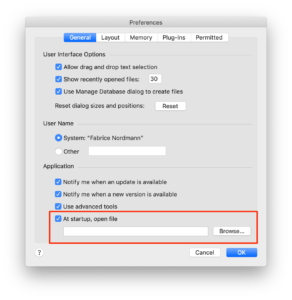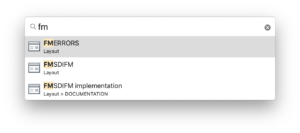FileMaker 19: Entering a New World
FileMaker 19 has just been released, and there’s a lot to be said about both the new features and the evolution of the platform in general.
Rather than publishing a long video as we usually do, we thought a feature article made more sense this time.
A few background elements first of all. Everything has changed this year at Claris, starting with the company name, still FileMaker Inc. less than a year ago. FileMaker 19 is thus the first major release since the name change, but also and especially since the arrival of a new management team, of which Brad Freitag (CEO), and Srini Gurrapu (Vice President of Products & Design) are the most visible members (but there are also changes at the marketing and sales levels)… in short, a lot has changed, and Claris’ – at first sight a bit naive – baseline “Anything is possible” actually makes sense.
In just a few months, everything that was impossible has become inevitable, therefore possible.
The effects are so numerous and so exciting that we couldn’t list them all, but let’s say a few words about the platform’s development cycles.
Development cycles
 First of all, it took Srini Gurrapu about 28 seconds to understand the anachronism of maintaining the Windows and Mac OS versions of FileMaker Server. Dependencies on Java and its implementations make it very expensive, and one of the first things announced at DevCon was that we would move to a single server, which Romain Dunand and I had understood to mean a Linux version. This was confirmed by the same Srini at the FM Conf in France in 2019.
First of all, it took Srini Gurrapu about 28 seconds to understand the anachronism of maintaining the Windows and Mac OS versions of FileMaker Server. Dependencies on Java and its implementations make it very expensive, and one of the first things announced at DevCon was that we would move to a single server, which Romain Dunand and I had understood to mean a Linux version. This was confirmed by the same Srini at the FM Conf in France in 2019.
So on the server, we now have – for testing purposes only at this stage – a Linux version in addition to the mac OS and Windows versions, and it is likely that the latter two will be history in a while. This doesn’t mean that you won’t be able to install a FileMaker Server on a Mac or a Windows PC, but likely the installation will include a Linux virtual machine or docker (Cent OS is mentioned, but other distributions can be used).
Regarding the development cycles themselves, FileMaker 19 is announced as the last numbered version. From now on, we should have a quarterly release instead of an annual one. So the next version should be 2020.1, then we’ll have 2020.2… This allows Claris to release features much faster, and even in a “preview” state in order to collect feedback from users earlier in the cycle. This is already the case with the Add-ons feature, present in version 19 but likely to change (and full of bugs by the way).
So we’re moving from an “old-fashioned” cycle, with functionalities fixed very early on, a big shindig in May with the need for functionalities to be “bling-bling” enough for marketing to do something with them, to much more agile deliveries and functionalities that are more adaptable and even closer to real needs.
Ecosystem
Maybe the first thing you notice is the change of icon. For nearly 30 years, FileMaker has been identifiable by a cardboard folder (here the icon of FileMaker 2.0, in 1992) [NB: the purists—not to say David Julot ;)—will point out to me that FileMaker 3 had committed an infidelity], and suddenly this image is abandoned in favor of a variant of the logo of the publishing company, Claris.
![]()
We must take into account the strategic aspect of this departure. Claris has freed itself from the FileMaker girdle by adding new strings to its bow: Claris Connect, which I’ll talk about below, and FileMaker Cloud. These two last ones make Claris a service company in addition to being a publisher.
Personally, I would have liked to have pushed logic to the point of changing the name of the product. FileMaker, the “file maker” (or—literally—the “traffic jams maker” in Dutch, a very catchy marketing statement …), doesn’t evoke anything to the generations that didn’t get to experience paper indexes. Incidentally, do you remember the infidelity committed by FileMaker 3.0 mentioned above?
![]()
So, even if we have to change, I must admit I would have been happy to get rid of this association with a bygone world, which is often worth remarks like “Hey, FileMaker! Does it still exists?” by people who knew the software in the previous millennium. But that’s not what has been decided. So let’s move on.
Speaking of name changes, have you noticed? FileMaker Pro Advanced has disappeared, we are now talking about FileMaker Pro (the software had been unified when FileMaker 17 was released, but we had opted – strangely I find – for the name “Advanced”). Maybe it was at first so people would not feel they were shortchanged. Nevertheless, must we keep such antediluvian name, it better be streamlined to the name everyone knows: FileMaker Pro. It’s done in 19.
Another very important point to note is the end of FileMaker Pro’s compatibility with 32-bit versions of Windows. The FileMaker platform thus completes its transition: it is 64 bits or nothing, server side as well as client side. Again, these are fewer versions to maintain, and more resources for development and innovation.
Probably for the same reason, the compatibility window has been reduced. Until now, the server supported clients up to 2 versions earlier or later (clients 14 to 18 could for example connect to server 16. However, FileMaker Server 19 is not compatible with FileMaker Pro Advanced clients 17, and vice versa.
The Runtime has disappeared, as announced 5 years ago. It is therefore no longer possible to distribute single-user standalone applications for Mac or Windows. Yet, existing runtime as well as copies of FileMaker 18 have not disappeared overnight, so there is still some time for editors of “runtime” applications to pull around. Notably, let’s recall that the iOS SDK allows to compile applications for iOS.
First impressions
The mac users can experience changes right from the outset. No more old-fashioned installer: just drag the application into the Applications folder, and off you go. Small extra bit incurred for those who, like me, work in English on a French (or any localised version) Mac OS: you have to pass the validation step. In other words: before fumbling around in the package contents to move the fr.lproj folder, you have to run the application once in French first, otherwise the validation will fail.
Another point: the Dark mode. For the followers of the Dark mode of Mac OS, all the FileMaker interfaces – except the relationship graph – have been adapted to conform. A calculation function is available to determine whether or not the application is running in Dark mode: Get (System Appearance). Personally, beyond aesthetic considerations, I adopted the dark mode for a few months to be able to report problems to Claris, but I confess that I had the impression of recovering my sight by reactivating the light mode. Nevertheless, we have several clients who work in dark environments (projection rooms, recording studios…), and who will be delighted with this evolution.
As a rather pleasing collateral effect, to implement Dark mode, Claris has been forced to modernise some interfaces, and several generations of buttons with different styles have (finally!) been standardised (for example the Manage Layouts window).
New features
There are many new developments, some of which have very important implications. If you are reading this long blog post on 1-more-thing’s website, it is because you know that although we are passionate about FileMaker, we maintain a freedom of tone and a critical eye. Therefore, you will find in the explanations below, as we usually do in our videos, some regrets or criticisms. Notwithstanding, know that overall we are extremely enthusiastic about this version.
I will discuss these new features in order of importance, which is of course, very subjective. Note that I will discuss FileMaker Go oriented features together at the end.
Add-ons
This feature is in “preview”, meaning that it is not bug free, and that it hasn’t delivered its full potential yet. But this feature will completely revolutionise the way FileMaker applications are designed.
Introduced as an example since FileMaker 17, add-ons can now be designed by third-party developers or by yourself. In Layout mode, you can simply drag an add-on onto the interface from the third tab in the left pane of Layout mode. In concrete terms, you can integrate a payment module, a calendar, a text editor, etc. in a few seconds.
From now on, I encourage you to bookmark our dedicated page.
A new script step, Save a copy as Add-on package, undocumented because in “preview”, is there to create an Add-on from an open window.
In terms of regrets—which it is once again a little early to have, the functionality being only in “preview”—we will note :
- impossibility to share some resources between add-ons (if two add-ons use the same function, it will have to be imported twice)
- no update mechanism (if the editor of an add-on releases a new version)
- obligation to have at least one table in an add-on. Too bad, it would have been a good way to share a theme, or a set of custom functions…
- no way (to my knowledge) to have some hidden or compiled code, or to implement a licensing system for add-ons.
Javascript integration
Two new features relate to javascript: the Execute JavaScript in Web Viewer script step and the ability to execute a FileMaker script from within Javascript: FileMaker.PerformScript
Intrinsically linked to the functionality of the add-ons because it allows to use Javascript as a component interface, we can however regret that in this implementation:
- Javascript can only be executed in a web viewer. It would be so convenient and powerful to be able to use Javascript in a calculation or script independent of the interface. Thus limited, one cannot take advantage of this new possibility in server scripts. Fortunately, there are third party plugins for that (including the excellent MBS)
- The FileMaker.PerformScript command does not control resuming a paused script in FileMaker. This is extremely unfortunate for synchronous programming, in which a paused calling script waits for the result of a user action in a web viewer.
- Finally, still no news of THE request from all developers since the introduction of web viewers in version 8.5 (2006): the possibility to get the content of a web viewer after javascript has been executed, with the GetLayoutObjectAttribute function.
Opening a default file
 These are the kind of little things that change everything. Already present in version 18, but reserved for scripted installations, a new preference appears in the interface.
These are the kind of little things that change everything. Already present in version 18, but reserved for scripted installations, a new preference appears in the interface.
Use it to configure FileMaker Pro to always open the same file at startup. The vast majority of FileMaker users always use the same custom application. Here’s something that will make their lives easier.
Small regrets:
- you still can’t define this setting by script, so you’ll have to go on each machine (except in case of scripted installation)
- in the remote open window, the path to a remote file is expressed as fmnet:/server/file and does not convert a possible URL to fmp://server/file. So we are not yet completely rid of these complicated explanations for an end user. A small memo here on our support portal.
Layout quick selector
 Another point that will this time change the life of developers: the selection of a layout by search engine.
Another point that will this time change the life of developers: the selection of a layout by search engine.
In template mode, use the key combination cmd-alt-K (Mac OS) or ctrl-alt-K (Windows) to activate a search engine to select a layout and quickly navigate to it. This will greatly improve the quality of life for Windows developers.
Execute FileMaker Data API
This script step, which makes its entrance in a very discreet way since it is not even mentioned in the documentation (!) is in itself a small revolution.
It exposes the Data API to the FileMaker Calculation Engine. In other words, if you know how to create a JSON query for the Data API, you know how to create a JSON query within FileMaker. In many cases, this can replace (advantageously) the ExecuteSQL function.
Rather than describing this script step in detail, I link you to a blog post by Todd Geist who has remarkably synthesised it.
Unfortunately, and although I’m convinced that this is a huge step forward (I’d be willing to bet that this script step will be used extensively in our applications), there’s still cause for regret.
- First of all, it was decided to implement this feature as a script step only and not as a calculation function. What a pity! So we find ourselves with ExecuteSQL which is a calculation function whose query object is the table and without any notion of context, and Execute FileMaker Data API which is a script step that queries a layout (template), and therefore with a notion of context. Make your choice! It would have been so wonderful to be able to request a context from within a calculation! Well, then if the calculation engine is not able to evaluate from an unrelated context it’s a good reason to go for a script step but…
- On the other hand, the big limitation of the ExecuteSQL function is that it only supports reading (SELECT), on the pretext that it’s a function, so it shouldn’t have a side effect (let’s skip over the fact that the plugin API has been allowing a plugin to bypass this for a very long time…). And so, the advantage of being a script step could have been to allow writing or executing scripts, which the Data API allows. Well no! Again, this new script step is limited to reading. One could say that, if you have activated the Data API on the server and the incoming data is not counted in the API consumption (limited according to your license), you just have to use Insert from URL to post data modifications. It would be forgetting that the response made by the Data API is an outgoing data and is therefore counted. Unfortunately, this can’t be a viable way to replace database queries, except for very limited traffic. In short, we’ve come very close to a revolution, but…
Number of pages and scientific notation
I’m not going to go long on those two points. They come with a good twenty years delay, which gave us plenty of time to find workarounds to these shortcomings, but finally… we can finally display the total number of pages of a printed document or a PDF without resorting to “tricks” and tips. Also, you can format a number in scientific notation format (in powers of 10) on the layout.
Card windows in Web Direct
The title says it all. Although card windows were already managed, they used to fill the whole browser window. Forthwith, we experience in Web Direct the behaviour we get in FileMaker Pro. I must admit that it wasn’t a subject that concerned me much. As long as we don’t have really responsive interfaces (with reflow) or onObjectMouseOver triggers, it seems to me that Web Direct won’t be able to create any illusions in terms of interface. It’s still very suitable for an intranet, but if you are demanding on the UX, custom development like we’re doing now with a real front end in Vue.js, and the Data API in the backend gives incomparable results, within very reasonable budgets. All in all, I’m not going to reach ecstasy with this new feature, but it’s clearly an improvement.
As for FileMaker Go …
The features below are not all strictly reserved to FileMaker Go, however it is in this framework that they are more relevant, that’s why I put them at the end of the list. Last but not least!
Core ML
Core ML is Apple’s framework that makes it relatively easy for iOS and macOS applications to integrate extremely complex artificial intelligence (AI) models.
What is implemented here are models that result in a string (more precisely: scalar data). Models returning, for example, a multidimensional image or array are not implemented.
In practice, the most useful models will undoubtedly be those of object recognition or regression… which will still offer very interesting things, for example in inventory or warehouse management applications.
The “functionality” is made up of two elements: a script step Set up the Machine Learning model, and a calculation function ComputeModel.
The compatibility indicated in the documentation is a Yes for FileMaker Go, and Partial for FileMaker Pro and FileMaker Server. This reminds us that CoreML is a component of macOS. Windows, Linux, or perhaps one day Android versions are not affected.
Reading NFC (Near Field Communication)
This is a very timely feature! At a time when any contact is considered a major health risk, FileMaker Go has the ability to interact with nearby objects. Thus, with the ease of implementing a card payment by means of add-ons (see above), it is also very easy to read a contactless card. This is only one of the many applications possible with NFC, and it is really very simple to do thanks to the Configure NFC protocol reading script step. Note that the iPhone arrived very late to NFC (the iPhone 6 already offered it but reserved it for payments with Apple Pay, and we had to wait for the iPhone 11 to be able to do something else, so we have to make sure that the hardware is compatible).
Siri Shortcuts
In these times of containment, it is reassuring to know that one can always, in case of extreme solitude, talk to Siri.
It is now possible to configure a script to be accessible through the Shortcuts application.
Well, I must admit that I’m not a big fan of voice interfaces but I tested it and it works well.
In case of space outings, don’t forget to configure a Siri shortcut for the door opening script, you never know.

The Universe and the rest
Of course there is still a lot to say about the features listed above. We will revisit Add-ons at length. Once again, it is the direction taken that is exciting.
Coupled with the integration of Javascript, Add-ons will truly revolutionise how FileMaker custom apps are created. Despite having a good head start on other comparable platforms, we have to admit that some of them also had their advantages, notably a modular architecture that was lacking. Not only is the delay on this point being made up, but we’ve just regained our lead on other points. FileMaker is becoming hardly questionable as a leader in low code platforms.
Claris Connect
I would like to conclude on a point that went almost unnoticed a few weeks ago: the new Claris Connect rates. When Claris Connect was released in March, we, who had tested it for many months and were very enthusiastic about the product itself, were, to put it mildly, a little embarrassed by the announced prices and plans. To put it less nicely and concisely: these prices could not in any way allow this new automation and orchestration platform to hatch and become a market standard.
It appears that we were not the only ones to think this way. Claris team’s response was swift and and intelligent. New prices have been published, which not only make the platform very interesting, but also make it a complementary tool to FileMaker. Indeed, if you are a FileMaker customer, the price for Claris Connect (FM Plus) has become very affordable. This means that we are really entering a much more modular world, where complex applications can be assembled more easily, whose components can be simpler, more robust, and whose maintenance is even better assured…
After a somewhat disappointing version 18, this version 19 is a giant step forward!
If you liked this article, feel free to leave a comment below.
I remind you that you can also select the FileMaker license that suits you best, thanks to our little module (developed in Web Direct!). Thank you for choosing us to order and manage your FileMaker licenses!

